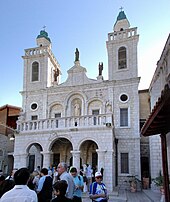Wedding at Cana


The wedding at Cana is a miracle story from the Bible that tells of how Jesus of Nazareth, as a guest at a wedding party, turned water into wine ( Jn 2 : 1–12 EU ). It is the first of the so-called signs ( Greek σημεῖα ) of Jesus, with which the Gospel of John introduces him as the Son of God and the Messiah and wants to lead the reader to faith ( Joh 20 : 30–31 EU ).
action
During the wedding celebration of a married couple with unknown names in Cana , at which Jesus with his disciples and his mother Mary are also present, the celebrants run out of wine. Jesus' mother asks him to help, but he harshly rejects her ("What do you want from me, woman? My hour has not yet come", Jn 2,4 EU ). After Mary asked the servants to do as he told them, Jesus gave them the command to fill the water jugs intended for ritual cleansing with water. "There were [...] six stone water jugs [...], each of which held two or three meters (1 meter ≅ 39.5 l)." When the chef (Greek ἀρχιτρίκλινος, festival steward) tastes it, he calls the groom and asks asked him why - contrary to normal practice - he kept the good wine until the very end, when the guests had already drunk too much to notice the quality.
interpretation
In the Bible, the wine symbolizes the festival and the joy of life ( Ps 104.15 EU ). He makes people feel the glory of creation. It belongs to the rituals of the Sabbath , Passover and marriage and is at the same time an essential part of the eschatological meal of joy ( Isa. 25.6 EU ).
This sign serves primarily to demonstrate Jesus' authority to the disciples who were only recently called , but at the same time to show that with Jesus the eschatological time of joy had dawned, in which mourning, fasting and renunciation are not appropriate ( Mt 9:15 EU ). The abundance of wine can be understood as an indication of the life in abundance that God intended for man ( Jn 10.10b EU ). It is noticeable that the Greek original prefers the term semeion " sign " and does not speak of thauma , " miracle ". Some exegetes adopted an originally independent text source of the Gospel of John as the so-called Semeia source , from which the evangelist took these signs. It was important to the evangelist that these signs themselves should not evoke faith. In the Gospel of John, a distinction is made again and again between seeing and believing, with faith being what is worth striving for even without seeing and without signs ( Joh 6.30 EU , Joh 6.36 EU , Joh 20.29 EU ).
The so-called wine miracle is popularly used as an example that the Bible does not call for alcohol abstinence .
The Biblical Cana
It is not entirely clear where the biblical kana was. It is mostly localized in Galilee, see Kana (Galilee) or Chirbet Qana . Sometimes the southern Lebanese village of Kana is identified with the biblical Kana.
Numerous archaeological finds confirm such clearly Jewish stone vessels in Israel in the 1st century. Due to the size of the vessels, it must have been an upper class wedding.
Worth knowing

In the Cathedral of Oviedo a stone vessel is issued, which should be on the local tradition of one of the six stone jars in which Jesus changed at the wedding at Cana changed water into wine.
reception
The Renaissance painter Paolo Veronese created the painting The Wedding at Cana , a famous tapestry is the Wedding at Cana (Villeneuve-d'Ascq) in France.
literature
- Walter Lütgehetmann: The wedding of Cana (Joh 2,1-11). On the origin and interpretation of a miracle story in the context of Johannine editorial history . Biblical studies 20. Pustet, Regensburg 1990 (402 pages) ISBN 3-7917-1243-8
- See also the relevant sections in the Commentaries on John's Gospel .
Web links
- The Wedding at Cana in the Modern Translation of the Bible Hope for All
- The wedding at Cana in the unrevised Elberfeld Bible translation
swell
- ↑ Lexicon for the Bible, 6th edition 2006 (C) 1994 R. Brockhaus Verlag Wuppertal ISBN 3-417-24678-4 , ISBN 978-3-417-24678-0
- ↑ Benedict XVI. : Jesus of Nazareth. From Baptism in the Jordan to the Transfiguration , Freiburg 2007, p. 293, ISBN 3-451-29861-9
- ↑ Udo Schnelle : The Gospel according to John. (= Theological commentary on the New Testament. Volume 4). 5th edition, Evangelische Verlagsanstalt, Leipzig 2016, ISBN 978-3-374-04317-0 , p. 89
- ↑ Jonathan L. Reed: The HarperCollins Visual Guide to the New Testament: What Archeology Reveals about the First Christians . HarperCollins, New York 2007, ISBN 978-0-06-084249-9 , here p. 5 : “Excavations all across Israel uncover such stone containers in first-century CE layers. They are distinctly Jewish […]. But large stone vessels are typically found only in wealthy homes and at urban centers. The mention of "large stone jars" in John 2 […] characterizes [the wedding] as an upper-class affair, a point that is not so obvious. "
- ↑ Labeling on the object in Oviedo Cathedral .
